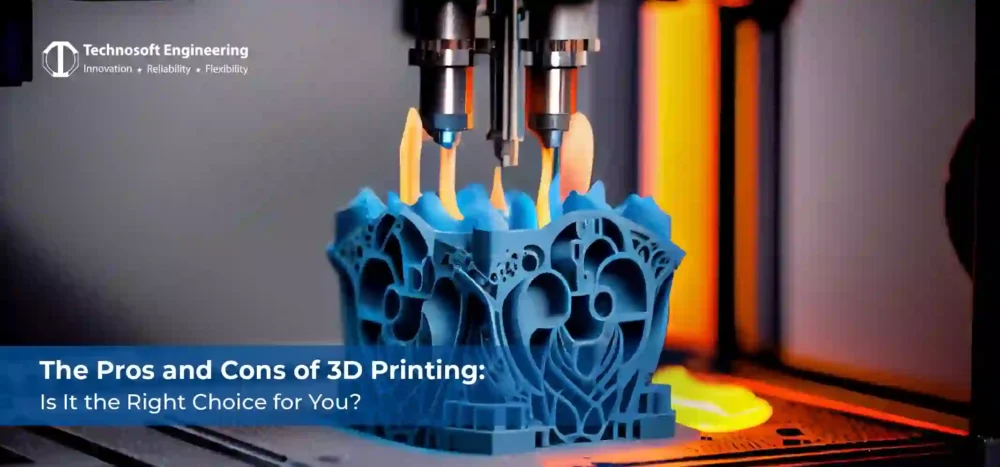
3D printing is revolutionizing manufacturing and prototyping, offering a new level of control and innovation. While it does have its drawbacks, understanding the pros and cons of 3D printing is crucial for anyone considering this technology for personal use, startups, or large industries.
Advantages of 3D Printing
1. Personalized Creations
One of the best things about 3D printing is the ability to make custom products. From personalized gifts to custom prosthetics, 3D printing lets you design and produce unique items that are tailored to your needs.
2. Rapid Prototyping and Manufacturing
3D printing allows you to create prototypes in a matter of hours, significantly reducing the time it takes to develop your products. This is a game-changer for startups and designers, enabling them to iterate and improve their designs quickly, leading to more efficient production processes.
3. Ideal for Small Startups
Entrepreneurs and small businesses can benefit from 3D printing because it allows them to produce small quantities of products at low costs compared to traditional manufacturing.
4. On-Demand Production
Unlike mass production, which requires large storage areas, 3D printing allows manufacturing on demand. Products can be created when needed, reducing inventory costs and waste.
5. Reduced Material Waste
Unlike traditional manufacturing methods, which remove materials from a larger block, 3D printing is an additive process that uses only the amount of material needed to produce a given part. This reduces waste and facilitates green production.
6. Enables 3D Reverse Engineering
3D Reverse Engineering allows manufacturers to re-create or improve upon existing products without requiring access to the original design files. This makes it easier to repair or modify older components.
7. Supports Complex Designs
3D scanning makes it possible to produce complex geometries and structures that would be impossible or very expensive using conventional methods. For more details, read about 3D Scanning.
Disadvantages of 3D Printing
1. Limited Build Size
Most consumer 3D printers have limited build volumes, so you can’t print large objects. Larger industrial 3D printers solve that problem, but they’re more expensive.
2. Limited Material Options
3D printing materials are limited compared to traditional manufacturing, but they’re growing. Common materials include plastics and some metals, but ceramics, glass, and specialized materials aren’t widely available.
3. Complex Post-Processing
3D-printed parts typically need support structures removed, sanding, painting, or UV curing after they’re printed, which adds additional time and labour to the process.
4. Copyright and Intellectual Property Issues
However, with the ease of 3D printing, the threat of copyright infringement looms since anyone can reproduce existing products without permission.
5. Slow Printing Speed
However, unlike mass production, where products are churned out quickly, 3D printing can be slow, particularly for large or high-detail prints.
6. High Initial Investment
Hobby 3D printers are inexpensive, but industrial 3D printers are costly. Also, high-quality printing materials and maintenance might increase your expenses.
7. Potential for Defective Prints
3D printing is still in its infancy, and many fail because of software errors, mechanical failures, or the wrong settings—wasting time and material.
Summary
In conclusion, these 3D printing pros and cons highlight the technology’s promise for rapid, customised manufacturing but also its limitations. Businesses and individuals should carefully consider these factors before adopting 3D printing technology.
Frequently Asked Questions (FAQs)
Q: Are 3D printer supplies expensive?
A: 3D printing materials Cost of basic filaments ( PLA, ABS ): 1500 – 4000 per kg specialized materials ( metal filaments ) more expensive
Q: How do beginners start using 3D printers?
Learning to use CAD software to create 3D models, convert them to STL files and use slicing software to prepare the model for printing can be daunting for beginners, but entry-level 3D printers and online tutorials can help.
Q: Can 3D printing be used for commercial production?
Yes, aerospace, healthcare, and automotive companies use 3D printing for prototyping and even end-use production, but large-scale manufacturing still relies on the old methods.
Do you want to use 3D printing in your business or personal projects? Discover how 3D Reverse Engineering and 3D Scanning can improve your designs. Get in touch with Technosoft experts today for tailored 3D printing solutions!